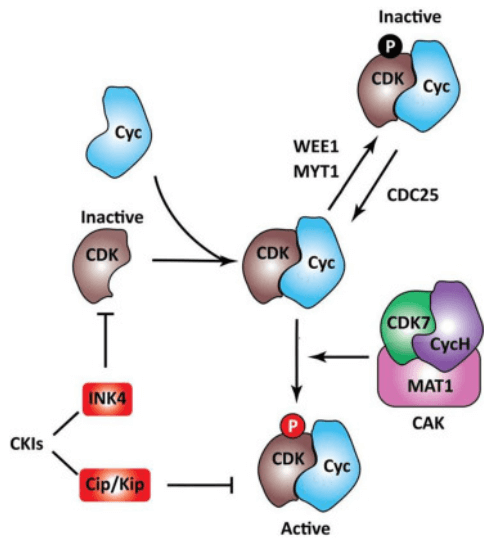CDK signaling pathway
Based on Luminex technology platform, Creative Proteomics provides analysis services for key targets of CDK signaling pathway.
 (Hisashi Tatebe, et al., 2019)Cyclin-Dependent Kinases (CDK) constitute a family of 21 different protein kinases involved in regulating cell proliferation, apoptosis, and drug resistance, and are evaluated in preclinical and clinical trials as chemotherapeutics.
(Hisashi Tatebe, et al., 2019)Cyclin-Dependent Kinases (CDK) constitute a family of 21 different protein kinases involved in regulating cell proliferation, apoptosis, and drug resistance, and are evaluated in preclinical and clinical trials as chemotherapeutics.
The CDK signaling pathway includes two types of regulation: positive regulation and negative regulation.
Positive regulation of CDK phosphorylation: located at position 160 of the conserved threonine residues in the amino acid sequence of CDK2. This residue is hidden in the T loop. After phosphorylation, the t-loop structure changes, the affinity of cyclin to CDK increases, and the CDK complex is activated.
Negative regulation of CDK phosphorylation: The inhibition of CDK complex activity shows that the simultaneous phosphorylation of the 14th treponin residue and the 15th tyrosine residue inhibits the activity of the CDK complex.
Cdk acts as a key step to drive the master regulator of the eukaryotic cell cycle. During the cell cycle process, Cdk is regulated by the interaction of cyclin subunits and inhibitory tyrosine phosphorylation. In addition, the activation of Cdk, like MAPK, requires threonine phosphorylation in the T loop. In budding yeast, PP2Cs, Ptc2 and Ptc3 effectively dephosphorylate this phosphorylated threonine in Cdc28 Cdk in vivo and in vitro. In humans, the corresponding threonine residues in Cdk2 and Cdk6 are dephosphorylated by PP2Cα and PP2Cβ2. The binding of cyclin to Cdk inhibited the dephosphorylation of PP2C in the two organisms, showing that PP2C only dephosphorylated monomeric Cdk.
Our detectable targets:
| RTK | PI3K | TYK2 | STAT1 | STAT2 | STAT3 |
| TNFR | ISGF3 | MSK2 | PI3K | TBK1 | Vav |
| STAT5 | IRAK4 | JNK | MYD88 | Rac1 | TLR4 |
| CREB | IRF3 | MAPK | NAP1 | Rel | TLR9 |
| MHC-II | IRS1 | MEK6 | p50 | SLP76 | TRAM |
| TCR | icam1 | Mda-5 | NFκB | RIG-1 | TRAF3 |
| GAS | IRF9 | MEKK1 | p38 | RIP1 | TRAF5 |
| PSGL1 | IRS2 | MSK1 | TLR3 | Tak1 | TRIF |
| CD3 | IRF5 | MEK3 | p38MAPK | SH2 | TRAF6 |
| Fas | ISRE | mTOR | PKR |
Technology platform:
We provide Luminex technology for CDK signaling pathway analysis.
Luminex technology is a multifunctional liquid phase analysis platform, developed on the basis of color microspheres, laser technology, applied fluid science and high-speed digital signal processing technology. It core is to encode polypropylene microspheres or magnetic microspheres with fluorescent dyes. By adjusting the different ratios of the two fluorescent dyes, up to 100 microspheres with different fluorescence spectra can be obtained. Antigen-antibody, enzyme-substrate, ligand-receptor binding reactions and nucleic acid hybridization reactions were performed on microspheres with different fluorescence codes. The microsphere coding and reporting fluorescence were analyzed qualitatively and quantitatively by laser detection.
As a proline-directed serine/threonine protein kinase, CDK plays a central role in controlling cell cycle progression.
In addition to Luminex Multiplex Assay, Flow cytometry (FACS analysis), Enzyme-linked immunosorbent assay (ELISA) technology can also be provided to meet other customer needs.
Advantages of CDK signaling pathway detection:
- High-throughput: Simultaneous analysis of multiple target molecules in the same sample. Theoretically, the detection flux is equal to the number of types of microspheres, that is, up to 100 types.
- Low sample consumption: Because 100 different target molecules can be detected in the same reaction well at the same time, the amount of sample is greatly saved; and because of the small size of the microspheres, as little as 1 puL of samples can be detected.
- Simple and fast operation: Since it is a liquid phase system, the reaction time is greatly reduced, and the detection of a variety of cytokines can be completed within 2 ~ 3 hours.

Application of our service:
- Study the impact of each clinical virus on the CDK signaling pathway
- Research on the regulatory mechanism of CDK signaling pathway in medicine
- Study the effects of drugs or therapies on the CDK signaling pathway
Creative Proteomics has developed a signaling pathway target detection platform. We can provide detection services not only for apoptotic signaling pathways, but also for other signaling pathways. If you want to detect other targets, please contact us in advance and we will customize the service for you according to your requirements. Looking forward to working with you.
References:
- Hisashi Tatebe, Kazuhiro Shiozaki, et al. Cdks are modulated by a series of CdK inhibitors (CKIs) that play a key role in establishing the activity of the cyclin-Cdk complexes in response to either external signals or internal stresses. Cell Cycle, 2019.
- Shen Shen, Dylan C. Dean, et al. Role of cyclin-dependent kinases (CDKs) in hepatocellular carcinoma: Therapeutic potential of targeting the CDK signaling. Hepatology Research, 2019,10(49): 1097-1108.



